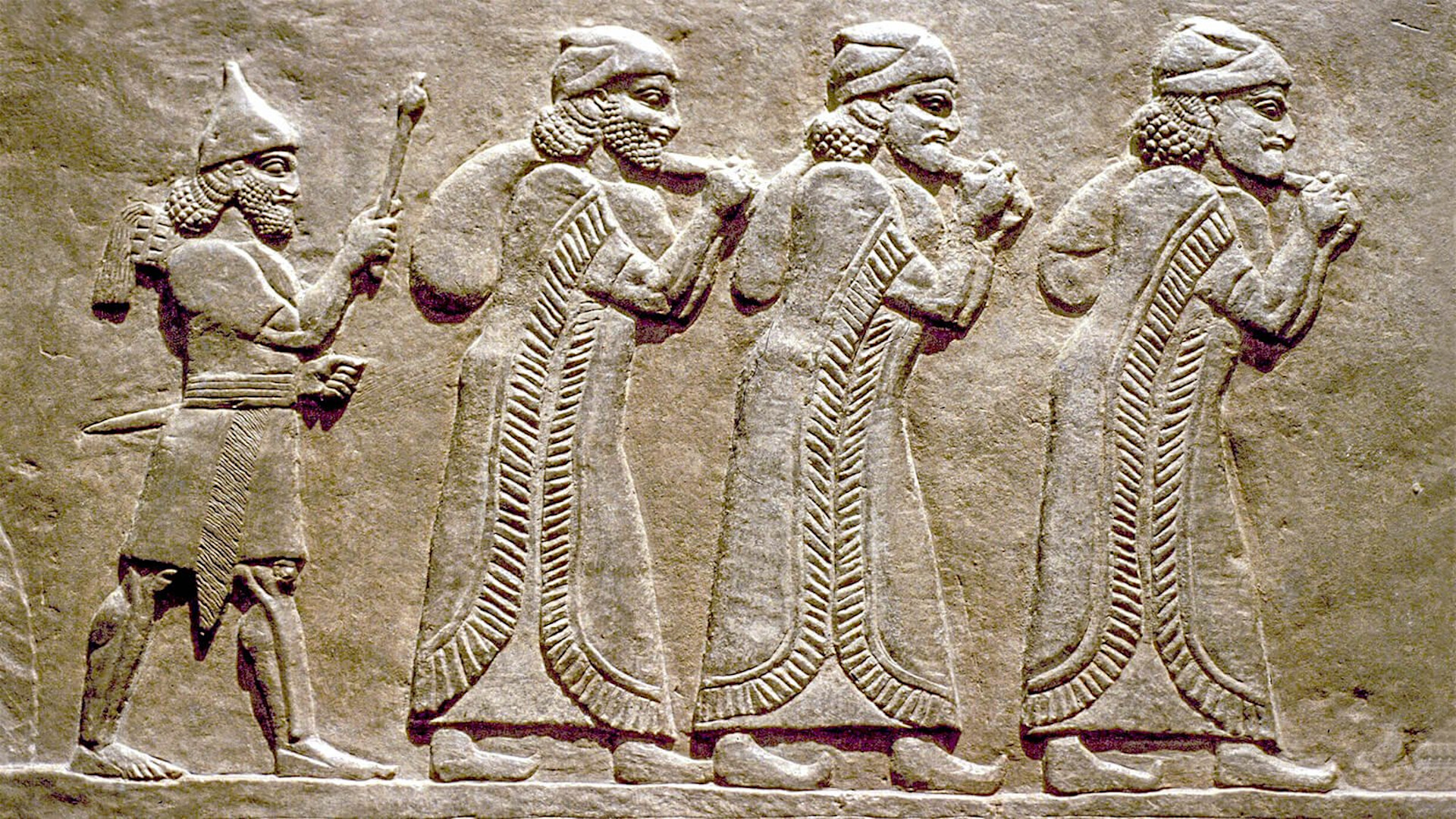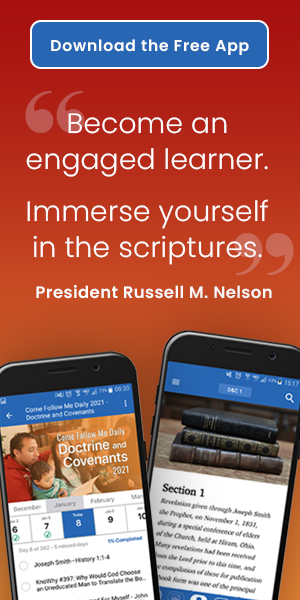You are here
Why Is the Great and Abominable Church Described like the Assyrian Empire?

1 Nephi 13:5
The Know
In the Book of Mormon, the prophet Nephi receives a broad vision of the history of the world (1 Nephi 11–15). In this vision, an angel shows him “that great and abominable church, which is the mother of abominations, whose founder is the devil” (1 Nephi 14:9).1 This church was shown to Nephi “presumably to teach him what led to the destruction of his envisioned descendants and how the devil works to destroy other ‘great’ nations.”2 As Todd Uriona has observed, many aspects of this vision clearly reflect aspects of the Neo-Assyrian Empire, a powerful kingdom in northern Mesopotamia from about 911 BC to the fall of Nineveh in 612 BC.
According to Uriona, “many of the ideas presented in Nephi’s vision are without a parallel in the Bible. Yet through the recent availability of Assyrian records, we find helpful context that seems to ground Nephi’s vision in a particular time and place.” Connecting the great church with Assyria, though perhaps foreign to modern readers, would have made sense for Nephi. After all, “it was the Assyrians who were initially responsible for the destruction of Israel and the exile of Nephi’s ancestors.” The brutal and ostentatious Assyrians had taken the northern ten tribes of Israel into captivity only a generation or two before Lehi and Nephi were born. Furthermore, “Nephi’s vision seems to contrast the [boasting] historical claims of the Assyrians,” including Nephi’s historical knowledge that the Assyrian Empire had just recently fallen, “against the Lamb’s future victory.”3
Indeed, several reversals of Assyrian tropes can be found throughout Nephi’s vision. Gordon Johnston observed, “Assyrian kings often used sheep imagery when boasting of the ease and brutality with which they defeated their enemies,” and many of the royal conquest inscriptions refer to the king slaughtering various kingdoms and cities like lambs.4 This “contrasts sharply with the constant repetition of the title ‘Lamb of God’ to describe the sovereign of Nephi’s vision,” that is, Jesus Christ Himself. In fact, “the overemphasized reference to the ‘Lamb’ throughout Nephi’s vision works in a profound way if it counters the Assyrian kings’ boast of easily slaughtering their enemies ‘like lambs.’”5
Another profound reversal of tropes is found in the detailed depictions throughout Nephi’s vision of how outwardly impressive the great and abominable church is. The angel told Nephi, “Behold the formation of a church which is most abominable above all other churches, which slayeth the saints of God, yea, and tortureth them and bindeth them down, and yoketh them with a yoke of iron, and bringeth them down into captivity” (1 Nephi 13:5, emphasis added). Furthermore, Nephi also records, “I also saw gold, and silver, and silks, and scarlets, and fine-twined linen, and all manner of precious clothing; and I saw many harlots,” all associated with this church, which the angel likewise links to this church’s desire to bring the Saints of God into captivity (1 Nephi 13:7–9).
Nothing in Nephi’s world could more emphatically match these descriptions than does the Assyrian empire. Indeed, like the Assyrian kings who claimed to slaughter their enemies like sheep, this great and abominable church sought to harm the saints of God—that is, those who believe in and worship the Lamb of God. Furthermore, “we are presented with specific descriptive elements” that link this wordly presence to Assyrian ideology.6
For example, as Johnston observed, the metaphor of a yoke of bondage “is distinctly Assyrian; it occurs rarely in the literature of other ancient Near Eastern nations.”7 In fact, this metaphor most typically appears in the Bible when referring to Assyria or warning that another nation would conquer Judah, just as Assyria had done to the Northern Kingdom.8 However, as Uriona points out, “Nephi’s use of the yoke metaphor is unique in that it contains the elements slayeth, tortureth, bindeth them down and bringing them down into captivity that are not easily explained by a relationship to the Biblical record.”9
All of these elements are found in Assyrian conquest reliefs, discussing the king laying “the yoke of his overlordship upon them.” Furthermore, the king was said to impale, maim, enslave, bind, and flay those who refused this yoke—just as the great and abominable church would do to the Saints of God. “The fact that we find so many of the same elements used to describe the Assyrian campaigns in Nephi’s description of the ‘great church’ is compelling evidence that the two might be related,” or at least could have been seen that way by the members of Nephi’s family.10
Finally, Nephi saw the great and abominable church gaining all manner of wealth and fine material in relation to capturing the Saints of God, and the Assyrian Empire was depicted similarly in their conquest reliefs. The king Assurnasirpal reported, for example, that he received “silver, gold, lead, copper, vessels of copper, cattle, sheep, garments of brightly colored wool, and garments of linen” as a tribute after he had flayed, tortured, and killed the royal leaders of the city Suru. In another account he likewise reported that he took “women of his [the king of Suru’s] palaces [and] his daughters” captive to be added to his own concubines.11 It is noteworthy, then, that all the stated desires of the great and abominable church are paralleled in Assyrian conquest reliefs, especially in the context of killing and capturing their enemies.12
The Why
While Nephi’s sweeping prophetic vision ultimately relates to events, nations, and institutions far into the future, no prophet writes in a cultural vacuum. The Lord often uses prophetic archetypes that can be readily understood across time and place because of their universal relevance to the people of God in all ages. Yet the Lord still “speaketh unto men according to their language, unto their understanding,” and prophets often use parallels from their own world to express and articulate these grand archetypes and universal human predicaments (2 Nephi 31:3).
As a symbol of those who oppose God’s kingdom on the earth, the great and abominable church is one of those archetypes, and it comes as no surprise that either the Lord would draw upon Assyrian imagery to reveal this archetype to Nephi or that Nephi would use such imagery from his day when writing and interpreting his vision (or both). By the time Nephi received this vision, the Neo-Assyrian Empire had already fallen in 612 BC. This empire had likely caused unparalleled sorrow and heartache for Lehi’s family, as they were from the tribes of Joseph and would have lost their ancestral homeland to the Assyrian conquest generations before. Furthermore, until recently the empire had been a threat to the Southern Kingdom of Judah, the land that Lehi’s family had long since made their new home.13
Showing Nephi a great and abominable church that paralleled the same nation that, until recently, had been a dominant world power would have helped Nephi understand the significance of this prophetic archetype. Like the Assyrian Empire, the great and abominable church attempted to rule over the people of God, and like the Assyrian Empire, the great and abominable church ultimately fell at the hands of the Eternal Father (see 1 Nephi 14:17). The strong use of Assyrian imagery would have served to reinforce to Nephi that all enemies of God will eventually meet that same fate, including this great and abominable church.
Nephi’s likening of future enemies of God to the Assyrian Empire was not foreign to Israelite practice. A similar methodology was likewise used by the community at Qumran, famously known for the creation of the Dead Sea Scrolls. In a commentary on Nahum, a book of scripture that deals with the fall of Ninevah and Assyria, this Qumran record sees Nahum’s interpretation as applying to “Demetrius, king of Yavan [Greece], who wanted to enter Jerusalem on the advice of the those looking for easy interpretations.”14 Demetrius lived long after the fall of Assyria, as he reigned during 96–87 BC and unsuccessfully attempted an invasion of Judaea. His failure fit the ancient archetype.
Other texts among the Dead Sea Scrolls similarly linked Nahum’s prophecies to the Babylonian conquest. In them, “the fate of Nineveh is transferred to Babylon.” A prerequisite for this, according to C. Hagedorn and S. Tzoref, is “the fact that Nineveh indeed fell in 612 B.C.E., thus providing proof for the authenticity of the prophecy.”15 As such, the Qumran commentators use the fall of Assyria—a historical reality—to demonstrate how other organizations will likewise meet the same fate. In the case of Pesher Nahum, the commentators turn to speak against “those looking for easy interpretations,” which many scholars believe refers to the Pharisees contemporary with the community at Qumran.16
Likewise, we can see how and why Nephi’s vision teaches important lessons applicable to all readers of the Book of Mormon. As we remain true and faithful to our covenants with God, we can have the assurance that all things will work together for our own good. When Jesus comes again, all God’s enemies will be destroyed and we will be set free from all sorrow and pain. As long as we strive to be Saints of God and continually worship and follow the Lamb of God, we will eventually be freed from all these things.
Further Reading
Todd Urioma, “Assyria and the ‘Great Church’ of Nephi’s Vision,” Interpreter: A Journal of Latter-day Saint Faith and Scholarship 55 (2023): 1–30.
Jared T. Marcum, “Withstanding Satan’s Siege through Christ’s Iron Rod: The Vision of the Tree of Life in Context of Ancient Siege Warfare,” Interpreter: A Journal of Latter-day Saint Faith and Scholarship 58 (2023): 1–18.
Stephen O. Smoot, “The ‘Fiery Darts of the Adversary’ in 1 Nephi 15:24,” Interpreter: A Journal of Latter-day Saint Faith and Scholarship 18 (2016): 5–9.
- 1. For a discussion on the two churches of Nephi’s vision—the church of God and the abominable church—see Book of Mormon Central, “Are There Really Only Two Churches? (1 Nephi 14:10),” KnoWhy 16 (January 21, 2016).
- 2. Todd Urioma, “Assyria and the ‘Great Church’ of Nephi’s Vision,” Interpreter: A Journal of Latter-day Saint Faith and Scholarship 55 (2023): 2.
- 3. Uriona, “Assyria and the ‘Great Church’ of Nephi’s Vision,” 3.
- 4. Gordon H. Johnston, “Nahum’s Rhetorical Allusions to Neo-Assyrian Conquest Metaphors,” Bibliotheca Sacra 159 (January–March 2002): 40. Johnston cites the royal conquest inscriptions from many Assyrian rulers, including Shalmaneser I, Sargon II, Esarhaddon, Tiglath-Pileser I, and Sennacherib, to show how this theme was prominent in Assyrian inscriptions. Many of these inscriptions are also cited as they appear in Johnston’s work in Uriona, “Assyria and the ‘Great Church’ of Nephi’s Vision,” 12, 27n67.
- 5. Uriona, “Assyria and the ‘Great Church’ of Nephi’s Vision,” 12–13.
- 6. Uriona, “Assyria and the ‘Great Church’ of Nephi’s Vision,” 6.
- 7. Johnston, “Nahum’s Rhetorical Allusions,” 27.
- 8. Examples of this can be found in Nahum 1:12–13 and Jeremiah 28:13–14.
- 9. Uriona, “Assyria and the ‘Great Church’ of Nephi’s Vision,” 6.
- 10. Uriona, “Assyria and the ‘Great Church’ of Nephi’s Vision,” 6–7. Citations of the relevant Assyrian texts relating to the yoke of the ruler and the punishments for those who reject it can be found on these same pages.
- 11. Cited in Uriona, “Assyria and the ‘Great Church’ of Nephi’s Vision,” 8–9.
- 12. For additional studies regarding how warfare employed by the Assyrians may be reflected in this vision as well, see Jared T. Marcum, “Withstanding Satan’s Siege through Christ’s Iron Rod: The Vision of the Tree of Life in Context of Ancient Siege Warfare,” Interpreter: A Journal of Latter-day Saint Faith and Scholarship 58 (2023): 1–18; Stephen O. Smoot, “The ‘Fiery Darts of the Adversary’ in 1 Nephi 15:24,” Interpreter: A Journal of Latter-day Saint Faith and Scholarship 18 (2016): 5–9.
- 13. For a discussion regarding Josephites living in Judah, and especially in Jerusalem, see Book of Mormon Central, “Why Did Lehi Live in Jerusalem? (1 Nephi 1:4),” KnoWhy 708 (January 9, 2024).
- 14. Pesher Nahum, 4Q169. Translation from Florentino García Martínez and Eibert J. C. Tigchelaar, eds., The Dead Sea Scrolls Study Edition, 2 vols. (New York, NY: Brill, 1999), 1:337.
- 15. C. Hagedorn and S. Tzoref, “Attitudes to Gentiles in the Minor Prophets and in Corresponding Pesharim,” Dead Sea Discoveries 20, no. 3 (2013): 480.
- 16. For a brief discussion on this, see Martin G. Abegg Jr., Peter Flint, and Eugene Ulrich, The Dead Sea Scrolls Bible: The Oldest Known Bible Translated for the First Time into English (San Francisco, CA: HarperOne, 2002), 455.
KnoWhy Citation
Related KnoWhys
Subscribe
Get the latest updates on Book of Mormon topics and research for free





